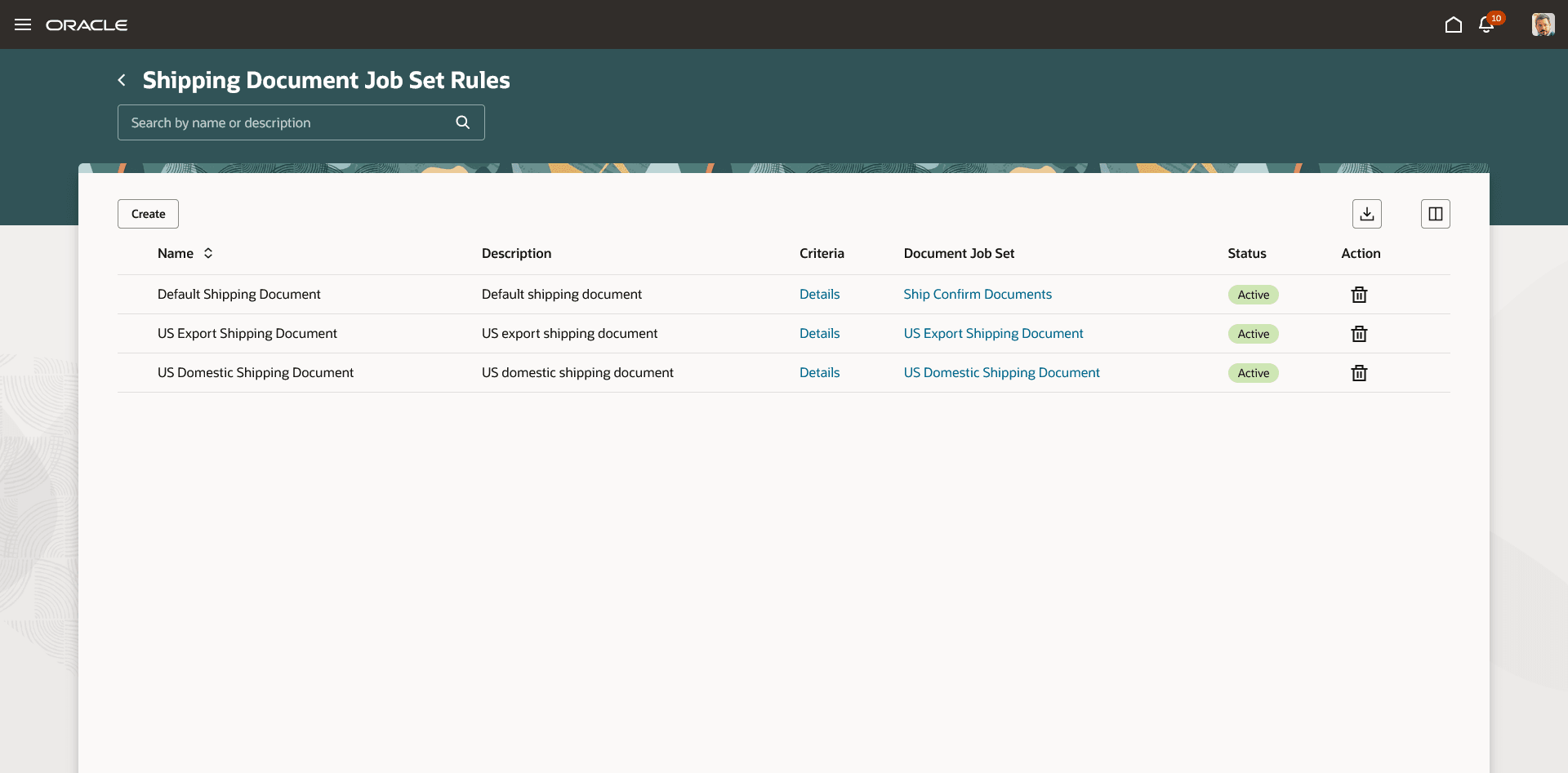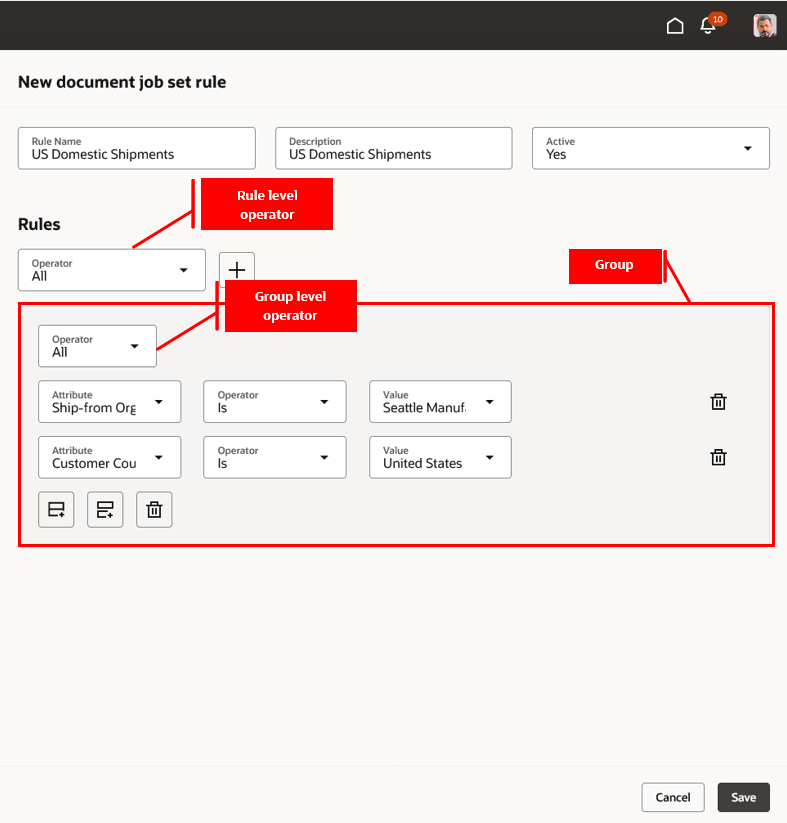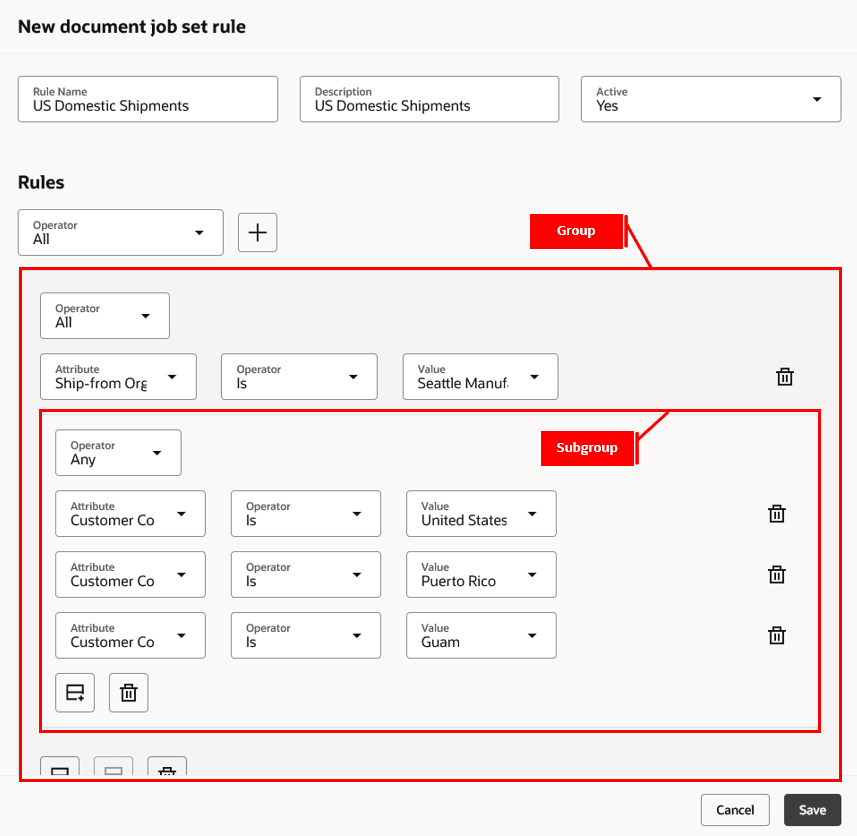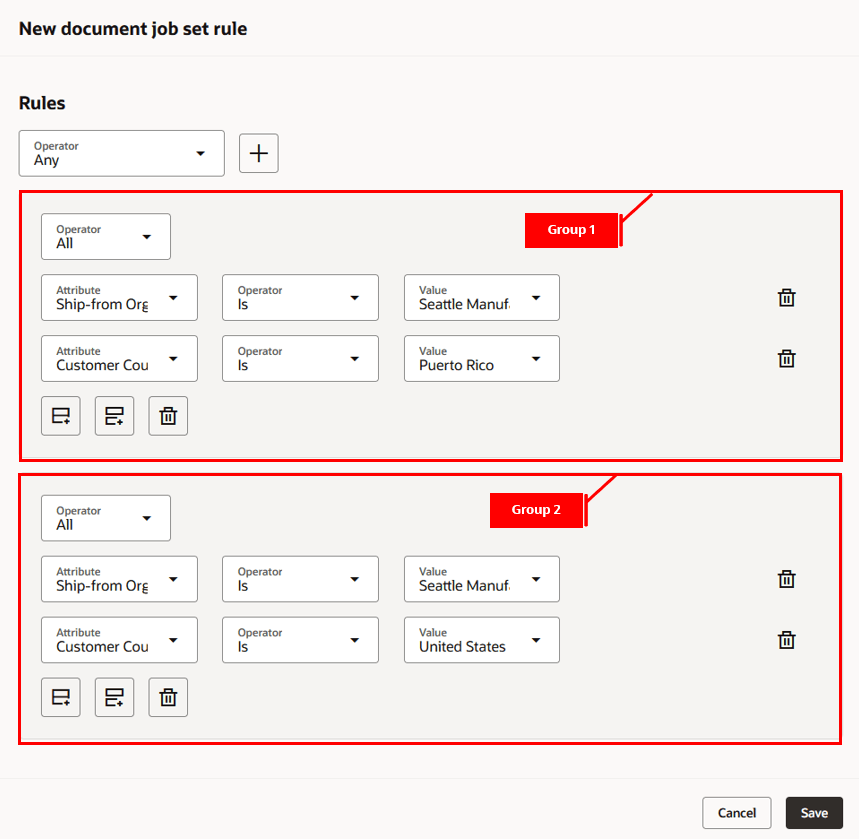Redwood: Manage Shipping Document Job Set Rules Using a Redwood Page
A shipping document job set is a group of reports generated at the time of pick release or shipment confirmation. For example, a shipping document job set could include required shipping paperwork such as the bill of lading, packing slip, and commercial invoice. Shipping document job set rules tell the application which document job set to select in order to generate the correct shipping documents. You can now manage you shipping document job set rules using a Redwood page.
You can access the Shipping Document Job Set Rules task from the Setup and Maintenance work area.
Using the new Shipping Document Job Set Rules page, you can:
- Search for and view shipping document job set rules.
- Create new rules by defining eligibility criteria and specify the document job set to apply when a shipment meets the criteria.
- Update or delete existing shipping document job set rules.

Shipping Document Job Set Rules
To create a new rule, click Create. This opens a drawer where you can specify the rule name, description, and eligibility criteria.
A rule consists of four key components: Group, Subgroup, Operator, and Attribute.
- A Group is a collection of eligibility conditions within a rule. It helps define whether a shipment qualifies for a document job set. Each group consists of conditions based on attributes, and the evaluation of these conditions is controlled by an operator. A rule can contain multiple groups, and the operator at the rule level determines whether a shipment must meet conditions in all groups or any one group.
- A Subgroup is a subset of conditions within a group that helps refine eligibility criteria further. It acts like an AND condition within the group, ensuring that multiple conditions must be met together before the group is considered satisfied.
- An Operator determines how conditions within a rule, group, or subgroup are evaluated. It defines whether:
- All conditions must be met (AND logic).
- Any condition can be met (OR logic).
Operators can be applied at different levels:
- Rule Level: Specifies whether eligibility is met if all groups or any group is satisfied.
- Group Level: Specifies whether all conditions in a group or any condition in a group must be met.
- Subgroup Level: Works similarly to group level but applies within a subgroup.
- An Attribute is a specific shipment field used to define eligibility conditions in a rule. Available attributes include:
- Carrier
- Customer
- Customer Country
- Customer Ship-to Site
- Order Type
- Ship-from Organization
- Ship-to Organization
- Shipping Method
Once the rule is created, click the Add hyperlink in the Document Job Set column and specify the document job set to apply for the rule.
Example 1:
A rule to evaluate whether a shipment is shipped from the Seattle Manufacturing organization and shipped to a customer located in the United States. In this case, you can create a group and set the Ship-from Organization and Customer Country as conditions within the group. By using the All operator, the rule will apply only if both conditions are met. This ensures that shipments qualify for the assigned document job set only when they are shipped from Seattle Manufacturing and the customer is located in the United States.

Rule with Single Group
Example 2:
A rule to evaluate whether a shipment is shipped from the Seattle Manufacturing organization and shipped to a customer located in the United States or one of the US territories. To achieve this, you can create a group and use a subgroup to include multiple country conditions.
- The Ship-from Organization is Seattle Manufacturing (set at the group level).
- The shipment is going to either the United States or a U.S. territory (handled using a subgroup).
- Since the Any operator is used within the subgroup, the rule applies if the Customer Country is either the United States or one of the US territories, while the All operator at the group level ensures the Ship-from Organization condition must always be met.

Rule with Group and Subgroup
Example 3:
The same rule can be structured using multiple groups, where each group contains a separate Customer Country condition. At the rule level, the Any operator allows the rule to apply if the shipment’s Customer Country matches any of the groups.

Rule with Multiple Groups
This feature provides you the ability to manage your shipping document job set rules more efficiently with an improved user experience.
Here's the demo of these capabilities:
Steps to Enable
Use the Opt In UI to enable this feature. For instructions, refer to the Optional Uptake of New Features section of this document.
Offering: Manufacturing and Supply Chain Materials Management No Longer Optional From: Update 25D
Tips And Considerations
- When a shipment is confirmed, the system automatically submits the Apply Document Job Set Rules and Output Preferences scheduled process to determine the document job set for printing. Once the feature is enabled, this process will use the rules defined in the new Shipping Document Job Set Rules page.
The new page does not retain existing rules from the Manage Shipping Document Job Set Rules task, so they must be manually reconfigured. Starting in 25D, this feature will be mandatory, and the system will rely only on the new rules. To avoid disruptions, it is important to migrate and set up all existing rules as soon as possible.
Key Resources
- Oracle Fusion Cloud SCM: Implementing Manufacturing and Supply Chain Materials Management guide, available on the Oracle Help Center.
Access Requirements
Users who are assigned a configured job role that contains this duty role can access this feature:
- Shipping Administration (ORA_WSH_SHIPPING_ADMINISTRATION_DUTY)
This duty role was available prior to this update.